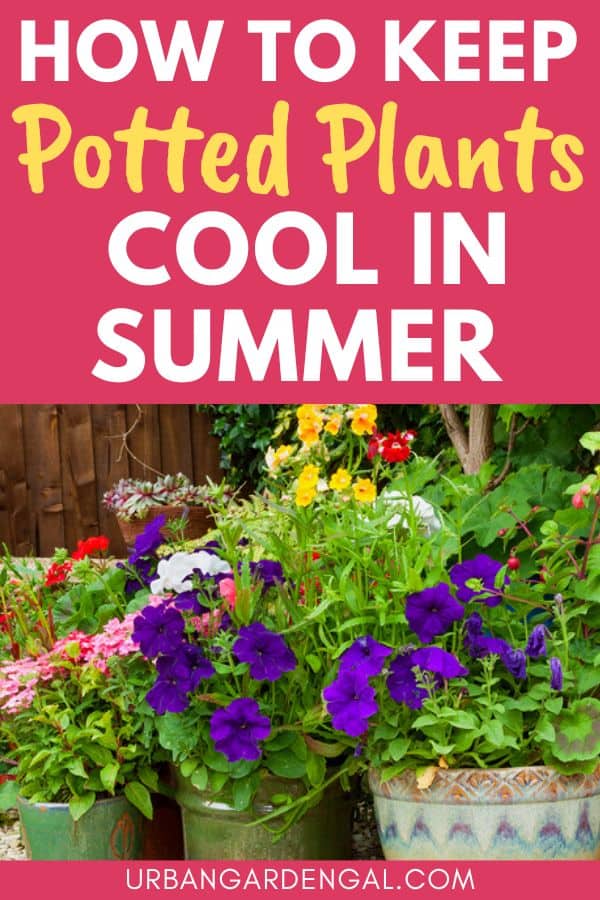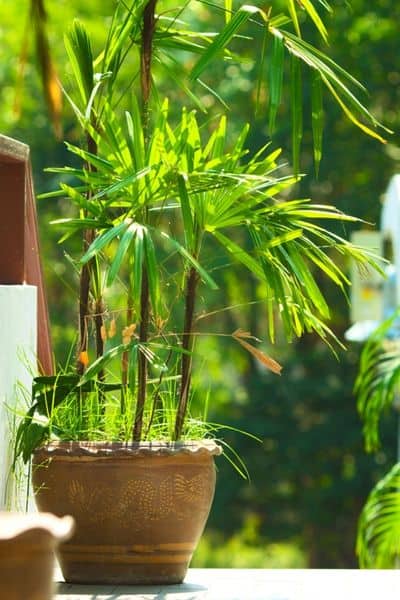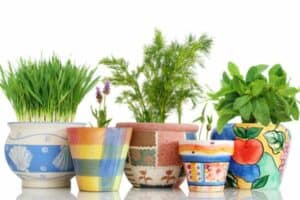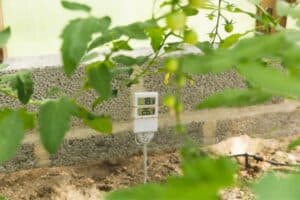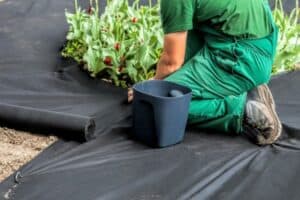Keeping potted plants cool in summer requires some clever strategies to keep them healthy during the hottest months of the year.
In this article I’ll share my tips for keeping container plants cool in the summer and maintaining their vibrancy throughout the season.
This post contains affiliate links. Please read the disclosure for more info.
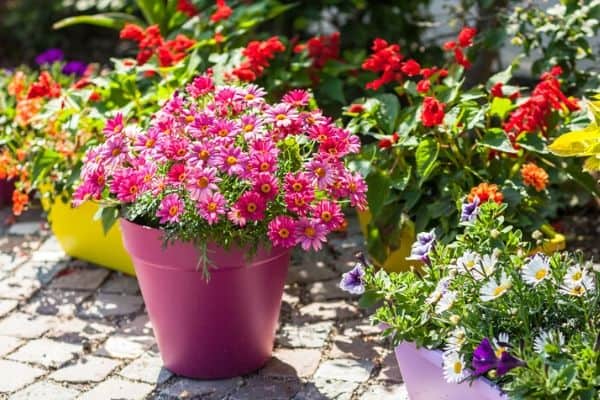
HOW TO KEEP POTTED PLANTS COOL IN HOT WEATHER
Move the Pot to a Partially Shaded Area
Moving your containers to a partially shaded area underneath a tree or pergola will help to keep them cooler and protected from direct sunlight, which can cause heat stress on hot summer days.
Take care to avoid placing pots on surfaces like concrete or asphalt because those surfaces absorb and radiate heat, which can make the soil dry out quicker.
I like to place large pots on a plant stand with wheels to make it easier to move them out of the hot sun.
The morning sun is not as harsh as the afternoon sun so it’s ideal if you can situate your potted plants in an area that allows them to bask in the sun’s rays during the mornings but is protected from the scorching afternoon sun.
If you haven’t got a covered area in your yard you can create some shade by installing a shade sail or large garden umbrella.
If you’re keeping your plants indoors, make sure they are not placed in direct sunlight coming through windows.
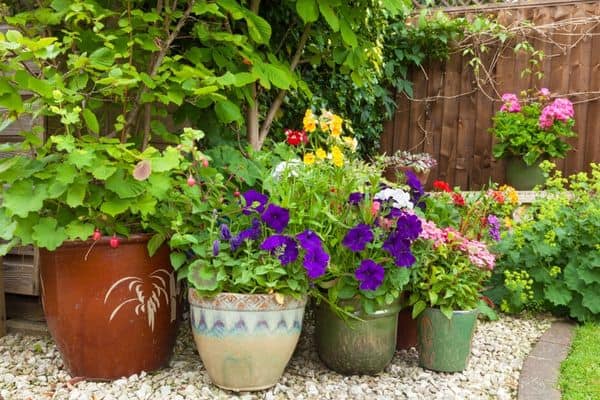
Water Regularly
Watering your container plants deeply is essential during the hot summer months because it encourages a strong root system and prevents the soil drying out too fast.
It’s best to water early in the morning or in the evening, when temperatures are cooler to reduce evaporation.
Use Self-Watering Containers
Self-watering containers are great if you don’t have time to water your plants each day because they store water in the lower section of the pot until it’s needed by the plant’s roots.
This eliminates the need for manual watering on a daily basis during periods of extreme heat and ensures that your containers always have access to adequate hydration.
The key is in choosing the right size container and making sure you fill the reservoir regularly
Choose the right pot
Use lighter colored pots whenever possible because darker colored pots tend to absorb more heat.
If possible, try to use terracotta, ceramic or concrete pots as they are more effective at reflecting heat away from your plants.
Just be mindful that plants in terracotta pots need to be watered more frequently than other pots because terracotta is a porous material that absorbs water.
You can place plastic pots inside a larger ceramic or terracotta pot to protect them from the hot sun.
When you double pot your plants, it creates an air gap between the two pots, which helps to reduce heat absorption and keeps the plant cooler on a hot day.
Place some bark chips, newspaper or cardboard in between the two pots to reduce heat radiating from the walls of the outer pot.
Plastic pots can also be wrapped in fabric to keep out the sun’s rays.
Use Mulch
Mulch is essential when container gardening in hot climates.
Add a thick layer of mulch, such as bark chips or white gravel on top of the soil.
According to the University of Minnesota Extension, mulch helps to minimize water loss from evaporation and moderates the soil surface temperature.
Mulch acts like insulation, keeping hot air out and trapping cool air near the plant’s roots which helps to keep them cooler on hot days.
Group Plants Together
Grouping plants together in a shaded area can create a microclimate that is cooler and more humid, which can be beneficial for plants on hot summer days.
Just be sure to position the plants so that they all have access to adequate light.
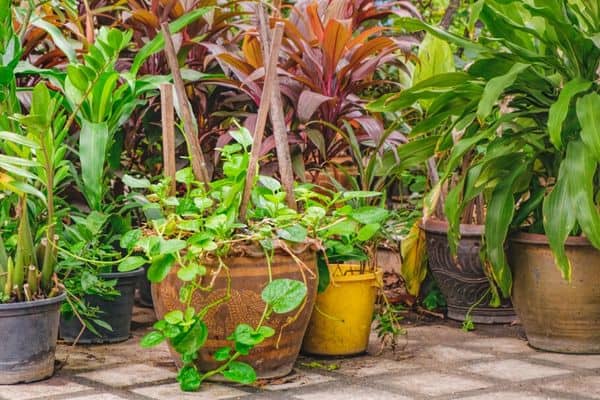
Avoid Fertilizing Plants During Hot Weather
Fertilizing potted plants during hot weather can be detrimental to their health.
When choosing fertilizer for your containers, opt for a slow-release formula that will provide nutrients over time instead of all at once.
These types of fertilizers are ideal because they don’t require frequent applications and won’t burn or shock the plants when applied in hot weather.
Excessive fertilizer can result in accelerated growth, making the plant more prone to heat strain, so stick with recommended application rates rather than applying extra just “for good measure” – this could end up doing more harm than good. [1]
Common Questions
How do you protect potted plants from extreme heat?
Placing potted plants in a shaded area is the best way to ensure they don’t overheat.
Water the pots deeply until the water drains through the bottom and check the soil moisture level every day or two.
What type of container plants do well in extreme heat?
Cacti and aloe vera are ideal pot plants for hot, dry climates due to their ability to store water in their leaves.
Other plants that thrive in hot climates include bougainvillea, agave, yucca, elephant ears and cast iron plant.
RELATED ARTICLES
- 12 Full Sun Container Flowers
- 10 Best Flower Bulbs For Containers
- 15 Full Sun Annual Flowers
- Advantages of Container Gardening
So there are my tips for keeping container plants cool in summer.
What methods have you found helpful for container gardening in a hot climate? Let me know in the comments below.
Are you on Pinterest? I have boards dedicated to Container Gardens and Growing Flowers that you may enjoy. You can also find me on Facebook.
